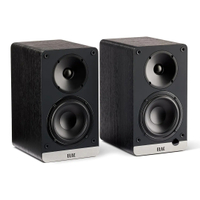Best turntable speakers 2025: top options for your record player
Active, budget and wireless speakers to pair with your vinyl system

What speakers should you pair with your turntable? The truth is, any pair of speakers will do; you simply need a pair that are the right size, design and sonic match for your record player that you can afford.
But there are a few more technical considerations to look out for in the system chain. The first is that a turntable will always need a phono stage and a stereo amplifier in between it and the speakers to make a sound. These elements can be found in individual boxes if you're gunning for a traditional hi-fi separates system, or they can be included within either the turntable or speakers themselves for a more streamlined music system. This is why the guide below is exactly that: a guide to all the various types of speakers available on the market that you can connect a turntable to, in various combinations.
There are traditional passive bookshelf and floorstanding speakers, but you can also use wireless speakers and active speakers with amplification built in. These speakers negate the need for a separate amplifier, and many of these active speakers now come with a phono stage built in too, so you can plug in a no-frills turntable directly. On the other hand, many turntables now come with their own phono stage built in, which makes it easy to connect to wireless and Bluetooth speakers, as well as all-in-one systems.
We would steer clear of turntables that also have speakers built into their chassis – in our experience, the vibration of the speakers affects the accuracy of the replay and overall sound quality to a detrimental degree that we're not fond of. Some cheaper models with built-in speakers can even damage your expensive records, and we don't want that.
Every pair of speakers on this list has been rigorously tested by the team of experts at What Hi-Fi? in our dedicated, bespoke listening rooms with the best turntables, ensuring you can trust our buying advice to the letter. You can read more about how to choose the right turntable speakers or scroll straight down to see our recommendations to inspire you.
The quick list

This multi-talented active wireless speaker system is a neat and straightforward way to stream music, but add a turntable with a phono stage and you’ve got a full-on hi-fi setup.

Looking for the simplest way to get sound out of your turntable? These active speakers will have you up and running in minutes – and they sound stonking, too.

Come for the good looks, stay for the extensive spec list (which includes a built-in phono stage) and eloquent, direct and balanced sonic performance.
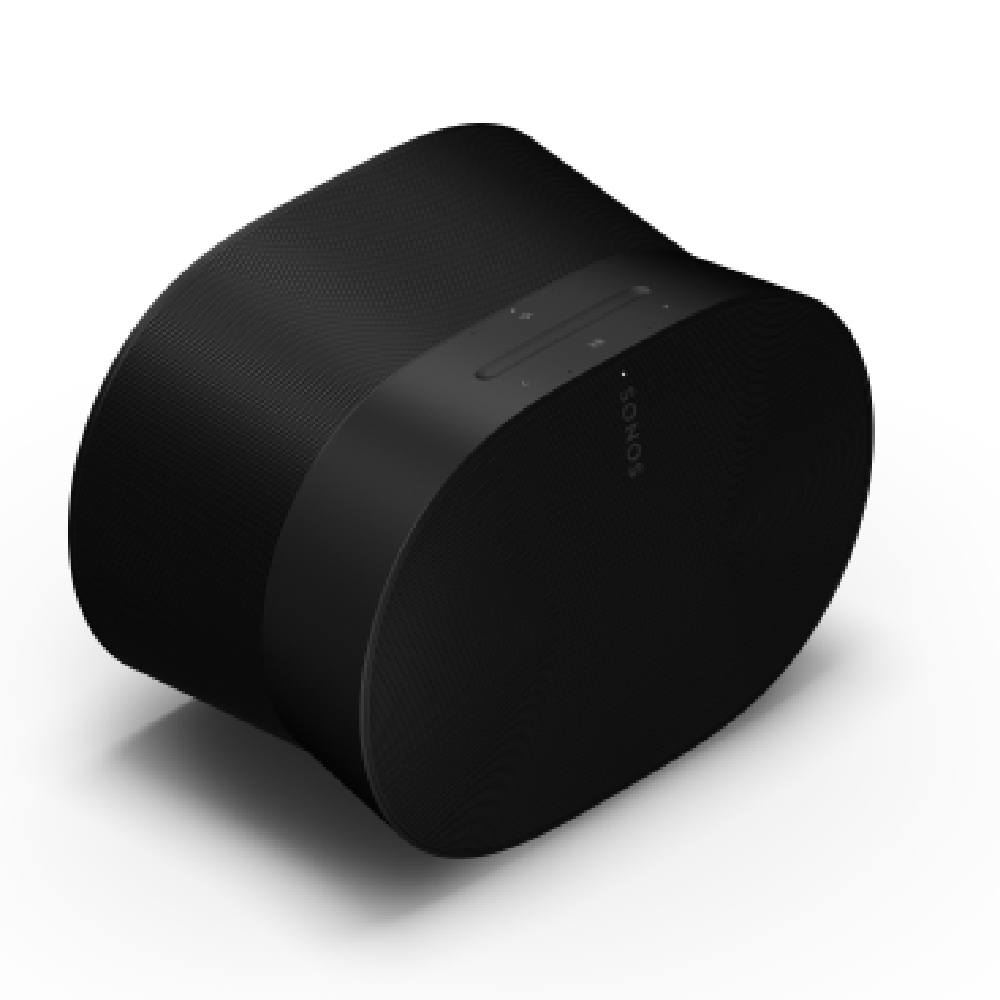
Spatial audio is the Era 300’s raison d'etre, but this smart speaker is also a hugely accomplished all-rounder – just don’t forget your adapter for plugging in a deck.

Ideal for those with both limited space and cash, these very capable passive standmounters are so fun to listen to that your ears will be glued to the hi-fi.

Crammed with ear-pleasing tech and sporting an understated but eye-catching aesthetic, these KEF standmounters set the standard at this price for any source.
Load the next three products ↓

Refined, entertaining and well-built, these affordable towers are good enough to claim a space in the Diamond’s hall of fame.

You can only get these Fynes in a single finish, but they deliver a cohesive, dynamic and detailed performance that is hugely entertaining at this price.
Read more below

I've been reviewing turntables, speakers and a variety of hi-fi products at What Hi-Fi? for over a decade, and have my own modest turntable set up at home. As part of my ongoing vinyl obsession, I've explored the various combinations of a turntable system – from full hi-fi separates to active speakers and even a Bluetooth set up. Modern turntable systems can take many shapes and forms, but the principles remain the same: good build quality and great sonic performance for the price. In this list, I've picked a variety of speaker suggestions that will work with most types of turntables on the market today, in various combinations and across all budgets.
The best active speakers




Specifications
Reasons to buy
Reasons to avoid
The Award-winning KEF LSX II is a stylish streaming system that comes with none of the baggage and multiple boxes that a separates set-up brings. Comprising a network streamer, a Bluetooth receiver and an amplifier all built into a pair of stereo speakers, the LSX II is a great option for those looking for convenience and musicality in two compact boxes. Nothing else really comes close at this level.
If you’re used to hi-fi kit coming in black, silver and various different wood finishes, the options KEF offers with the LSX II will come as a pleasant surprise. You can choose Carbon Black or Mineral White, but the Olive Green, Cobalt Blue and Lava Red are all rather fetching.
These 200-watt speakers run on KEF’s W2 wireless streaming platform, so while the original LSX offered plenty of choices when it came to sources – streaming over DLNA or from Tidal, Spotify Connect and Apple AirPlay 2 – the LSX II expands on this with wider streaming support and the modern-day addition of HDMI ARC and USB-C for TV and laptop connectivity respectively. There’s no phono stage, but if you have a record player with one built in, the LSX II’s integrated amp means you can just plug it straight in.
An Ethernet port allows native playback of 24-bit/96kHz digital music files, plus KEF’s own low-latency wireless connection supports anything up to 24-bit/48kHz (anything above either is simply downsampled for playback). They can also decode DSD256 and MQA files.
You don’t have to listen to the KEF LSX II for long to realise you’re in the presence of some very capable speakers. There’s a real sense of refinement and maturity to the sound without being showy; laid back but expressive when required.
The UniQ drivers produce a bubble of sound with vocals that hang right in the middle of the soundstage. Tonally, the whole presentation is extremely inviting and shows a lot of natural warmth. And this rings true whether you’re listening to the speakers in a more conventional set-up on the stands or you’re sitting more up close and personal using them on a desktop.
Their size limits how low they can go, but there’s enough weight for the bass notes to feel full and wholesome. Bass is tight and controlled, too, with a nice layer of texture on the surface of the notes. It's a satisfying performance and a neat, stylish system overall.
Read the full KEF LSX II review
Also consider: If you’ve got the extra cash to spend and could be tempted into something a bit more hefty, the KEF LS50 Wireless II are £1999, but they don’t come in as many colours. If you want a more affordable alternative, the five-star KEF LSX II LT offer the same performance and design but fewer connections for £899 / $999 / AU$1695. Bargain.
The best active speakers with phono



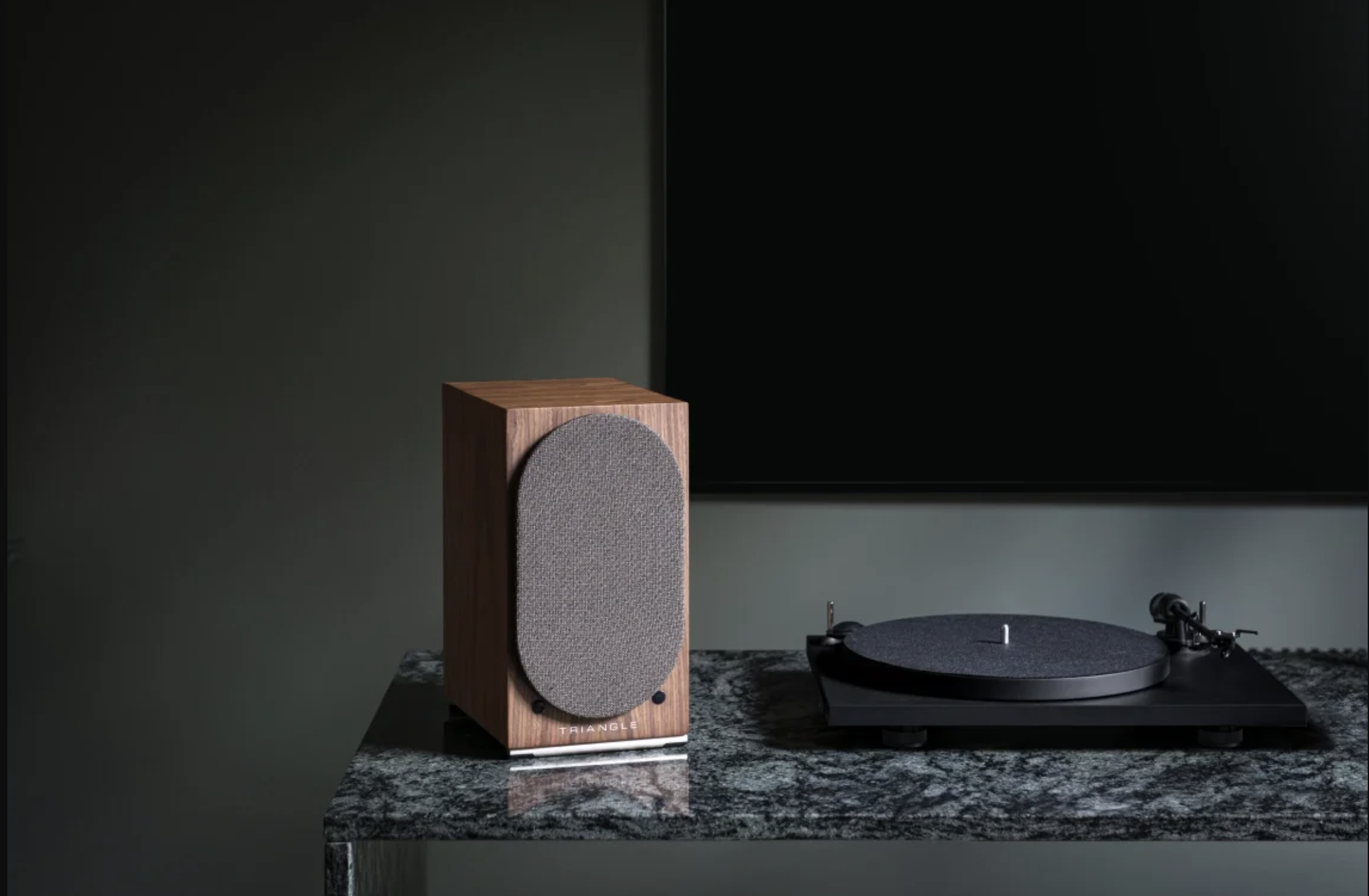

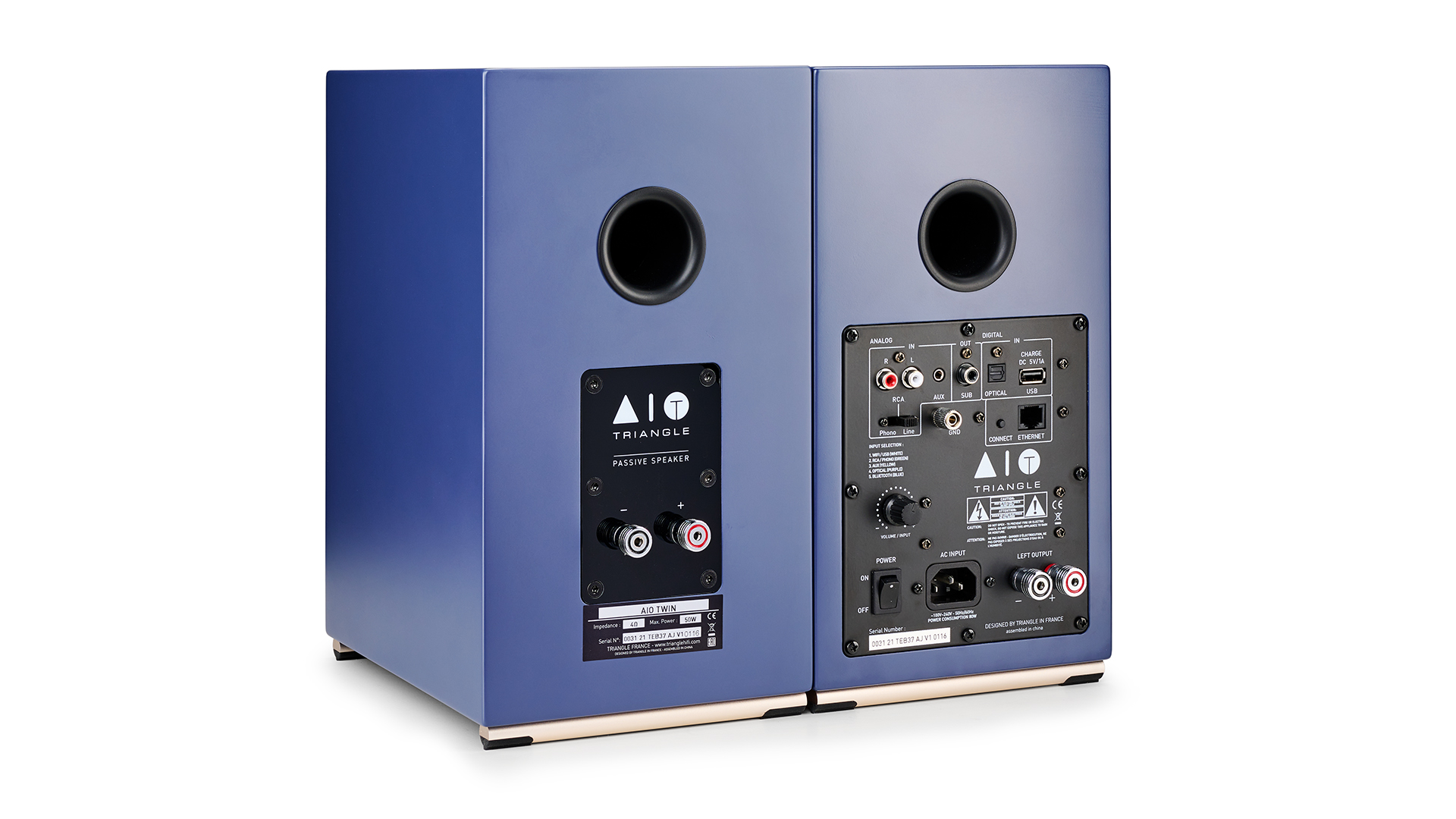

Specifications
Reasons to buy
Reasons to avoid
If the turntable you own doesn’t have a phono stage and you want to keep your setup as simple as possible, look no further than the Triangle AIO Twin. This is a neat, elegant system that does it all (nearly), with a built-in phono stage meaning you can simply connect your deck to the dedicated phono inputs and you're good to go. It puts on the kind of sonic performance that makes you want to keep on listening – and you don’t have to pay over a grand for it.
All of the amplification, streaming circuitry and connectivity is situated in the ‘master’ speaker, with a cable to connect the second passive unit, but both house 13cm mid/bass drivers and 25mm tweeters. They’re classy and compact cabinets, which are available in six fetching colours.
The inputs are all neatly labelled, with a key that corresponds to the LED on the front, which changes depending on which source is active. As well as the RCA analogue inputs, there are also optical, ethernet and 3.5mm sockets, plus wi-fi and Bluetooth if you’d prefer to ditch the cables. It’s all easy to set up and manage thanks to the Triangle AIO app, which also allows you to create a multi-room system if you have other compatible Triangle products. The only thing it’s really missing is some customisable EQ settings.
All the major streaming services are supported – Spotify, Tidal, Deezer, Amazon Music, Qobuz – and hi-res audio support goes up to 24-bit/192kHz.
Paired with a decent turntable, such as the five-star Rega Planar 2/Nd3 or Pro-Ject Debut Evo 2, these speakers sound peppy enough to get you singing along, but they perform even better when streaming over wi-fi.
It’s a system that’s incredibly fun to listen to, with a confident and composed delivery. There’s also ample power, space and bass, especially considering the speakers’ dimensions.
It’s also worth noting that they have rear-firing ports, so while you can be pretty flexible with where you position them, you’re advised not to place them too close to a wall as they need a bit of space to breathe.
Read the full Triangle AIO Twin review
Also consider: If you want a more affordable pair of active speakers with a built-in phono stage, the £339 Elac Debut ConneX DCB41 are a great option for budget turntables such as the Pro-Ject Primary E or Rega Planar 1. The five-star Elacs don't have streaming smarts built in, but they are versatile speakers with Bluetooth, USB, optical, HDMI and the analogue inputs can be switched to phono or line level. You could, for instance, plug in the superb Rega Planar 1 Plus, whose built-in phono stage is of a better quality than the Elacs'. Unfussy, insightful and balanced sound are the highlights of the Debut ConneX's performance.
The best all-in-one
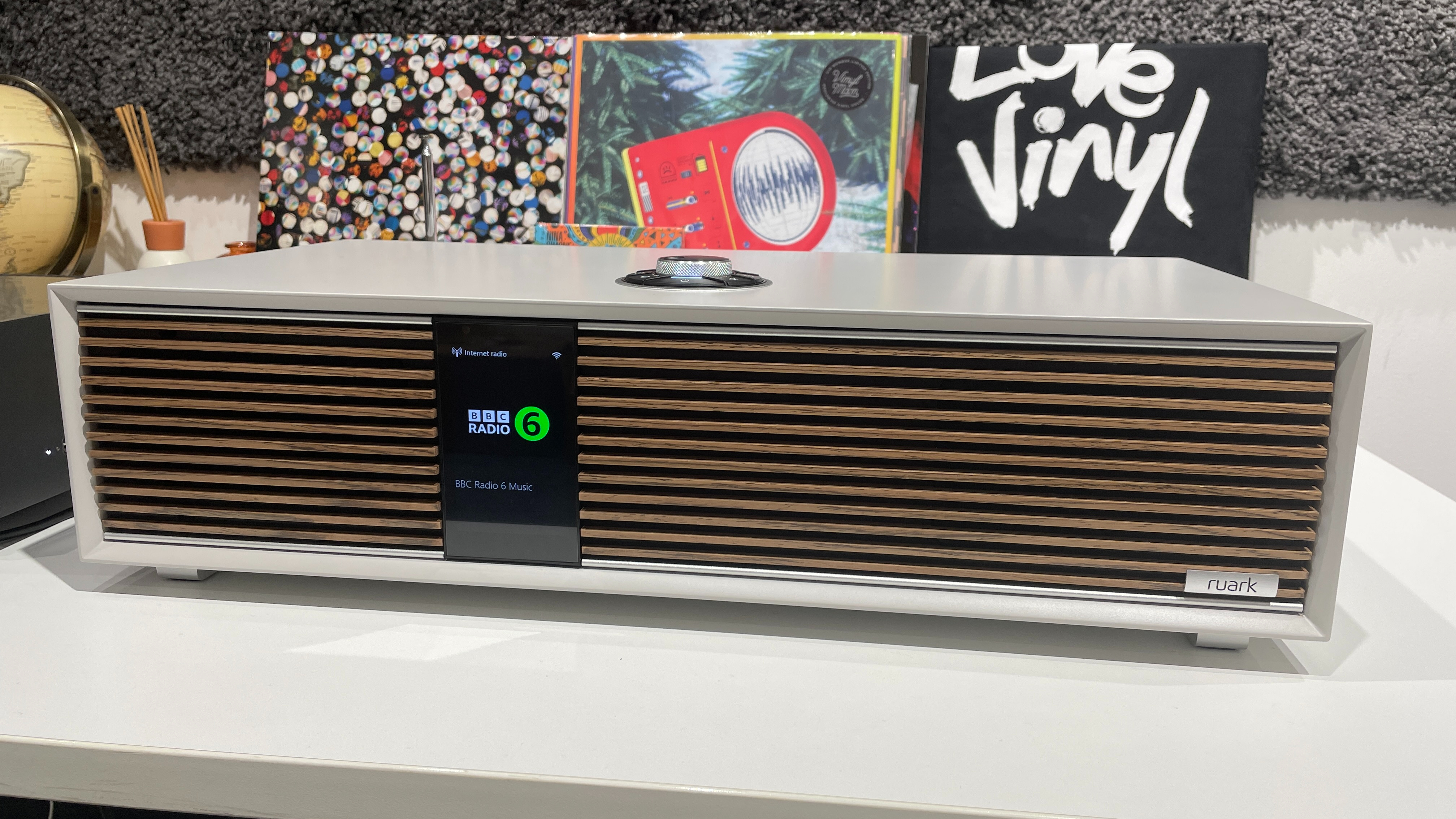



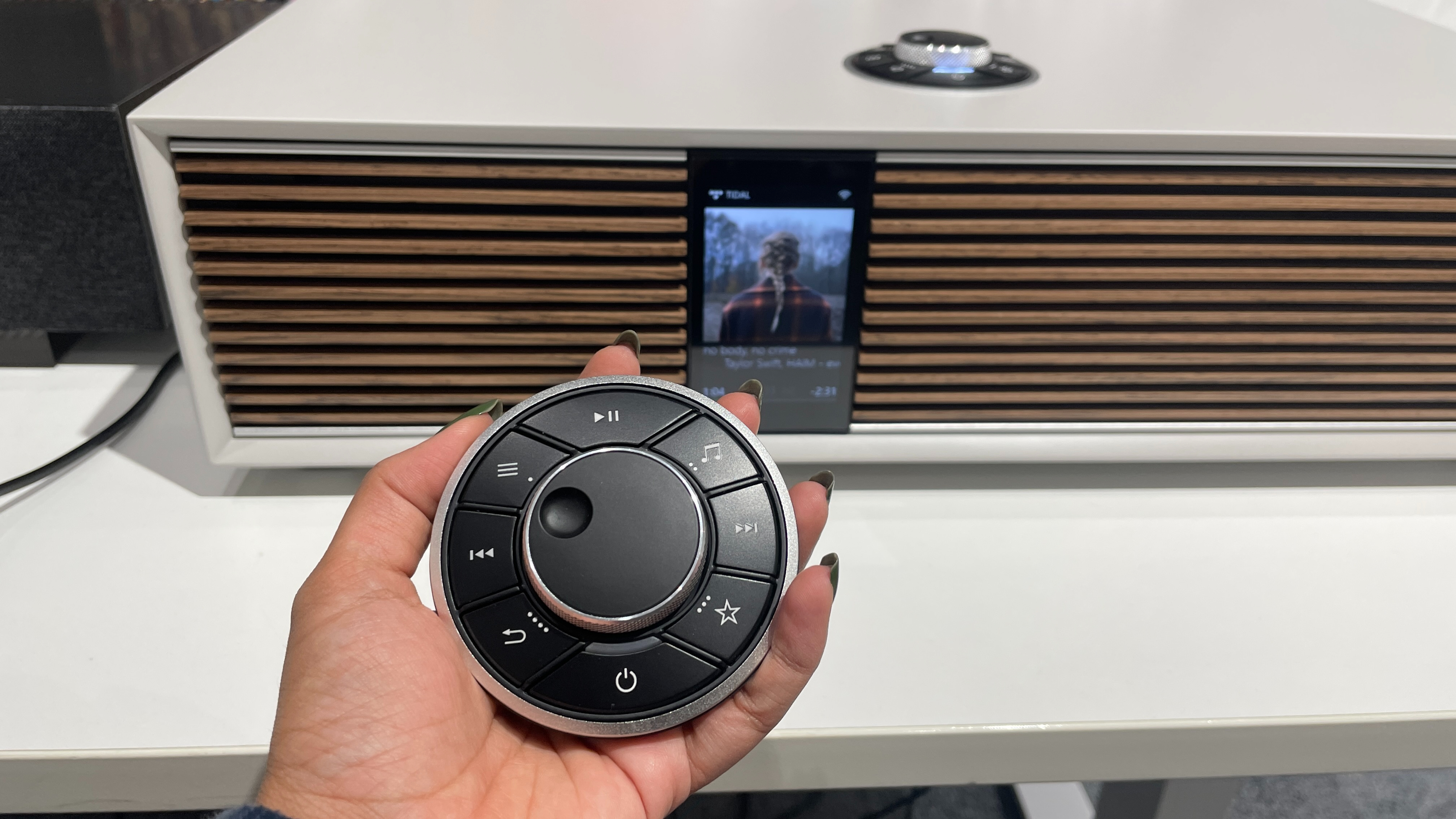
Specifications
Reasons to buy
Reasons to avoid
The concept of an all-in-one music system might seem a little old-fashioned to some, but if you’re looking for something that looks every bit as good as it sounds the Ruark R410 certainly ticks both boxes – and with a moving magnet phono stage onboard you don’t need anything else to connect your turntable either.
The Ruark R410 is available in two finishes – walnut and soft grey – but whichever one you choose it’s guaranteed to attract attention and elicit admiring comments. Build quality is equally impressive.
There’s certainly nothing old-fashioned about the R410’s feature set either. There’s dual-band wi-fi, Bluetooth 5.1 (with support for SBC, AAC and aptX HD codecs), FM/DAB/DAB+ and internet radio, and even HDMI eARC in case you want to use it with your TV as well.
With all those options it could do with more controls on top, and a dedicated control app wouldn’t go amiss, but the 4-inch portrait-style screen on the front is bright and crisp, if a little on the small side.
Behind the wooden grille is a pair of 20mm silk dome tweeters and a couple of 10cm paper cone mid/bass drivers, with two bass reflex ports on the bottom to provide low-frequency reinforcement. They’re all powered by 120 watts of Class D amplification.
The result is remarkably consistent no matter the source, offering a genuine sensation of unity and singularity to its sound, and no obvious sensation of crossover. The sonic performance is positive and confident without being brash or overly assertive, although it’s worth knocking a couple of dB off the bass output in the EQ settings.
It’s perhaps not the most dynamic sound you've ever heard, and it doesn’t create the most expansive soundstage either, but there’s decent momentum and good rhythmic expression, and detail levels are high across the whole frequency range. It has no problem filling a room with sound either, even if it can’t quite reach the very loudest volume levels.
Read the full Ruark Audio R410 review
Also consider: If you’ve got a few more quid to spend, the Sonus Faber Omnia and Cambridge Audio Evo One are worth a look, but if you’re not into the wood finish and already have a phono stage, Naim’s excellent Mu-so 2 is a fine alternative for an all-in-one system.
The best smart speaker
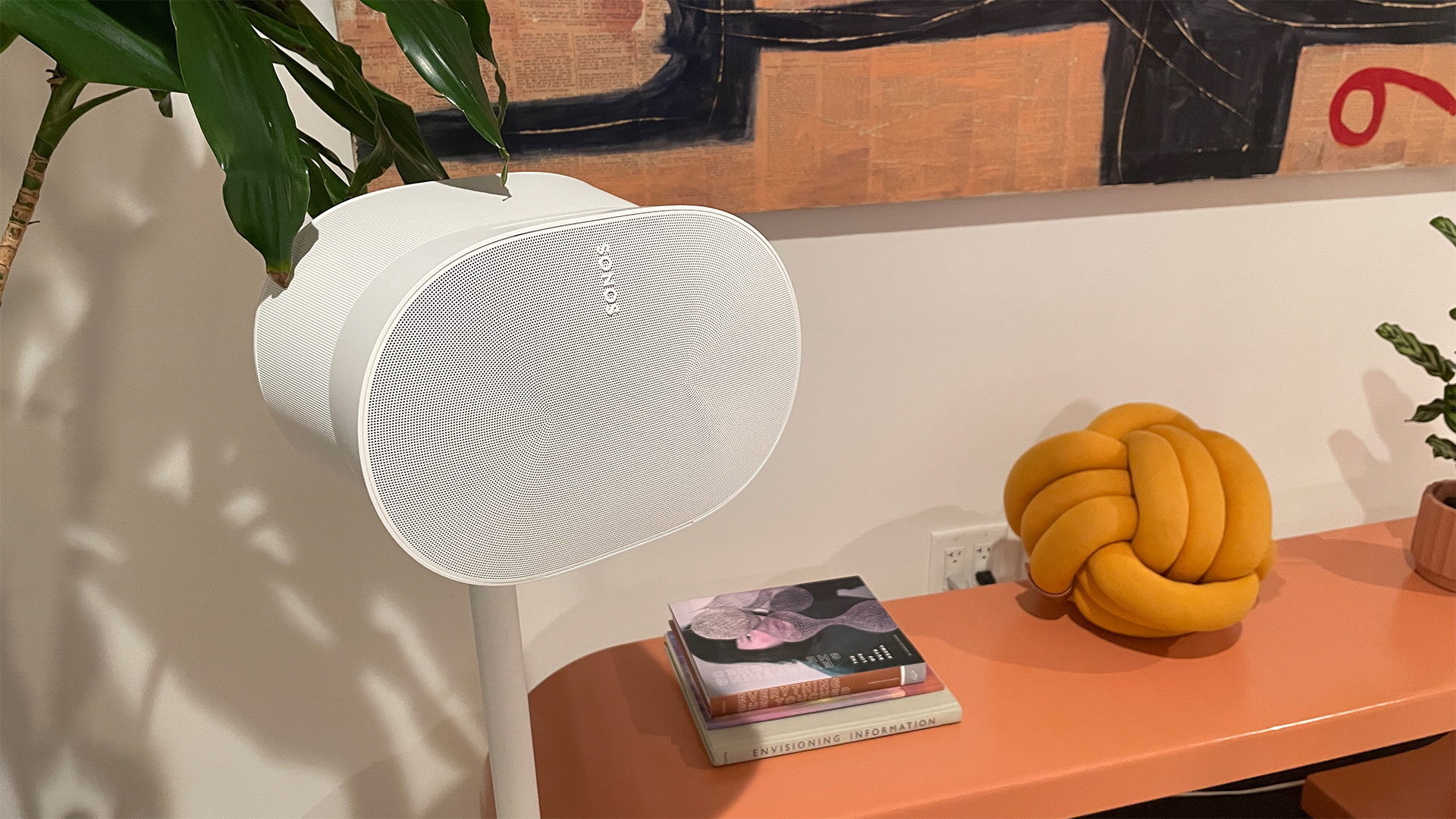





Specifications
Reasons to buy
Reasons to avoid
Ushering in the era (if you’ll excuse the pun) of spatial audio, this innovative Sonos speaker is an excellent way to combine two musical formats from opposite points in history. The Sonos Era 300 has Bluetooth, so you can connect your Bluetooth turntable for a wireless connection. If you want to go wired, that's also possible. You need to buy a £19 line-in wired adapter to physically connect your turntable, and there’s no phono stage so the deck will need one of those too. But the Sonos performs brilliantly no matter whether you’re listening to something mixed in Dolby Atmos or just good old-fashioned stereo.
The Era 300’s unusual shape is born out of necessity, with six drivers that are angled to fill every corner of the room with sound. There are responsive touch controls on top, although chances are you’ll operate it almost exclusively via the Sonos app, and you can have one in any colour as long as it’s black or white.
Of course, spatial audio support is the headline feature here, but don’t forget what made Sonos famous in the first place: its excellent multiroom capabilities and streaming services support. Voice control is provided by Sonos’s own AI assistant, although if you want to do more than just control music playback you’ll have to use Amazon’s Alexa instead, which is also onboard. Google Assistant is no longer supported.
While vinyl records might not be able to take advantage of its spatial audio skills, even in stereo the Era 300 sounds solid and cohesive. There’s ample detail and fluid dynamics to each song, with songs thrown out into the room with the kind of scale and power we’d normally hear from much bigger speakers.
With Dolby Atmos tracks that effect is even more pronounced, with sound that completely envelops you. It’s so convincing that it’s hard to pinpoint where exactly the music is coming from. How well the effect is communicated does vary depending on the song and how it’s been mixed for spatial audio, but for the most part, we enjoy the effect from the Sonos Era 300.
Spatial audio is only available via Amazon Music and Apple Music, and you need to be using wi-fi rather than Bluetooth, but there’s support for a huge range of streaming sources when it comes to stereo playback. If you’re an Amazon or Qobuz subscriber you can also listen to 24-bit/48kHz hi-res files.
Read the full Sonos Era 300 review
Also consider: Bluetooth turntables such as the Audio Technica AT-LPW50BTRW are easy to pair with the Ero 300. We would recommend the Sonos Era 100 if you want a budget alternative while still retaining all of Sonos's streaming features and connections. If you don't care about spatial audio, the new Award-winning Audio Pro C20 offers a better stereo sound for the same money.
The best budget standmounts





Specifications
Reasons to buy
Reasons to avoid
The smallest and most affordable stereo speakers that B&W makes, the 607 S3 are ideal for smaller spaces. Perhaps the best thing about them is that they clearly know how to have fun, which means you need to be careful with how you partner them, but get the balance right and you’ll have fun listening to them too.
You can always rely on B&W to produce a classy and well-built product and this third iteration of the Award-winning 607 series doesn’t do anything to spoil that reputation. It might be fairly tough to tell the different generations apart but considering they all look more expensive than they are, that's no bad thing, even if the asking price for the S3 has gone up.
Inside each of the cabinets, which come in black, white or oak, you’ll find a 13cm Continuum mid/bass driver, plus a two-part 25mm decoupled double dome tweeter. The two are mounted closer together than before to improve integration, and B&W has taken technology that was first introduced in its more expensive products and integrated it here for improved all-round performance. That means titanium for the tweeters, with an elongated tube-loading system at the back and new grille design on the front; a more powerful motor assembly backing the mid/bass driver; and a redesigned terminal layout round the back to keep things nice and neat.
The B&W 607 S3 need no time to impress and we’re struck by just how entertaining and musical they sound right from the start. Even songs we listen to regularly for testing purposes sound full of pep.
That doesn’t mean they fall short in other areas though. They sound rhythmically cohesive, agile, and well-organised, with a more open-sounding overall presentation. Clarity is superb and detail is crisply revealed. Despite their small footprint the 607 S3 have no problem filling up a small-to-medium room, with very little distortion creeping in when you crank up the volume, and they even manage to remain tuneful and dynamic when we turn the dial the other way.
Read the full Bowers & Wilkins 607 S3 review
Also consider: B&W has very much hit the sweet spot between great sound and an affordable price tag with these crowd-pleasing speakers, but if you can’t quite stretch to a pair, then Wharefedale's Diamond 12.1 or Dali Oberon 1 are excellent alternatives. Got a few more quid to spend? Try the bigger, next-level-up Bowers & Wilkins 606 S3.
The best premium standmounts
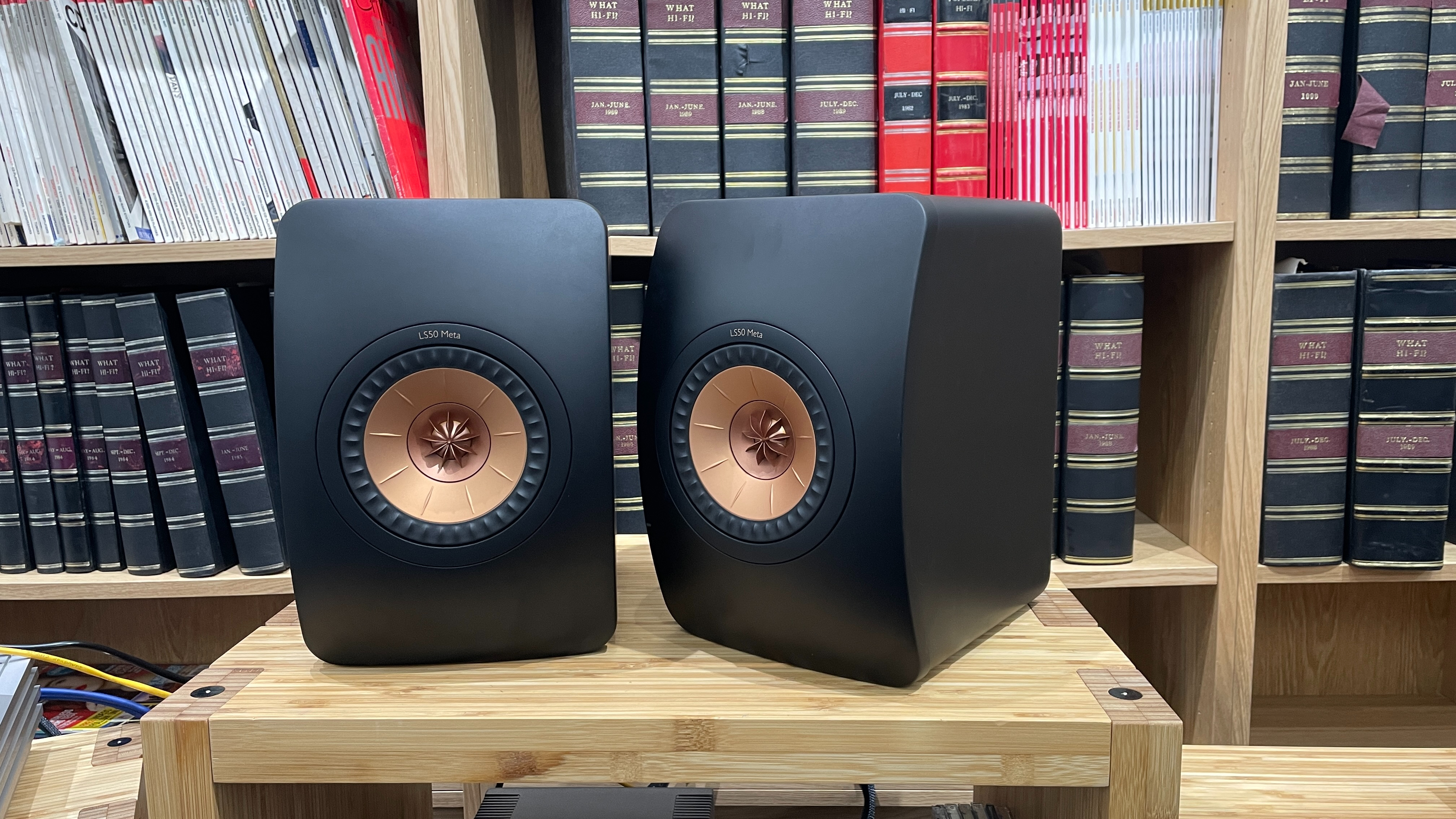




Specifications
Reasons to buy
Reasons to avoid
When KEF launched the LS50 Meta in 2021 it took an already brilliant pair of standmounters and made them even better. Three years later and they’re still top of the class, combining exceptional sound quality, modern aesthetics and solid build – it’s no wonder they’re multiple What Hi-Fi? Awards winners.
Made from a combination of heavily braced and carefully damped MDF, with a curved front panel constructed from Dough Moulding Compound, the LS50 Meta manage to look contemporary without any danger of suddenly becoming dated. After all, the original LS50 were launched in 2012 and they still look fresh. If it ain’t broke…
The big changes are on the inside, where KEF has reworked the Uni-Q driver array and added Metamaterial Absorption Technology (MAT) to cope better with the sound that comes off the back of the 25mm aluminium tweeter dome. It’s proprietary tech that has trickled down from the LS60 Wireless and results in a cleaner, less distorted high end.
At just 30cm tall they’re pretty compact, but don’t take that as an invitation to squeeze them onto a bookshelf or push them right up against a wall; they’ll sound their best on stands with a bit of space around them. These aren’t particularly sensitive speakers either, so it makes sense to partner them with an amplifier that has a bit of grunt, such as Cambridge Audio’s CXA81 or the Arcam A15.
If you’ve heard an original pair of LS50 speakers the sonic character of the Meta will be immediately familiar, but there’s no doubt they’re a significant improvement. They sound so much cleaner and more sophisticated than before, particularly at higher frequencies.
The sound is surprisingly full-bodied considering their compact dimensions, with a good degree of authority to the presentation and a decent amount of punch to the bass. Large-scale dynamics are handled well and there’s plenty of muscle; these speakers rarely sound stressed unless volume levels are high.
They’re also much more transparent than before, rendering low-level details, such as instrumental textures, much more convincingly. It won’t take long for you to marvel at their delicacy and precision, and the soundstage is expansive and tightly focused, layering instruments convincingly.
Read the full KEF LS50 Meta review
Also consider: If your budget can stretch to the Q Concerto Meta you’ll get more low-frequency reach and openness, and if you’d prefer a more traditional look, PMC’s Prodigy 1 sound slightly better, but not drastically so. If your speakers need to be placed inside a bookshelf, the superbly entertaining Epos ES-7N are perfectly suited to the task.
The best budget floorstanders



Specifications
Reasons to buy
Reasons to avoid
It’s tough to make a truly talented floorstander and sell them for an affordable price, but that’s exactly what Wharfedale has managed with the Diamond 12.3. If you’re looking for a pair of refined, entertaining and well-built turntable speakers, these are a superb, Award-winning buy.
At 98cm tall, the Diamond 12.3 aren't a particularly imposing pair of floorstanders, so they'll fit into most spaces with relative ease, but you will still need to give them a bit of room to breathe. As for build quality, the cabinets are carefully crafted with a traditional straight-edge design and a tidy feet arrangement. The 12.3 are available in four finishes – black, walnut, white and a classy light oak – all of which belie their relatively modest price tag.
They utilise a 2.5-way design where the upper 13cm driver covers everything from midrange downwards, leaving the second one to reinforce the lows. A carefully shaped faceplate leaves as much of the 25mm tweeter exposed as possible, and the contouring closest to the dome is there to provide a small degree of horn loading.
Thanks to a relatively sophisticated crossover, the Diamond 12.3 have a sensitivity of 89dB/W/m and a minimum impedance of 5ohms, which means these floorstanders are unlikely to give any decent price-compatible amplifier a problem.
The Wharfedale Diamond 12.3 deliver a lovely layered sound that’s brimming with detail and dynamic nuance. They resolve a large amount of information but also present it in an organised and controlled way.
The drive units are well integrated, delivering an articulate and expressive midrange, while the low end is agile, satisfyingly rich and textured, with enough weight to satisfy without spoiling the balance of the presentation.
Crank up the volume and these speakers don’t complain, with punch and power when required, but also a level of subtlety that’s rare to find in a floorstander at this price. They also sound good at lower levels, so you don’t have to push them hard to bring them to life.
Read the full review: Wharfedale Diamond 12.3
Also consider: The fantastic Dali Oberon 5 and refined, spacious B&W 606 S3 are great alternatives if you want even bigger sound and can afford the higher price tags for your turntable set up.
The best premium floorstanders
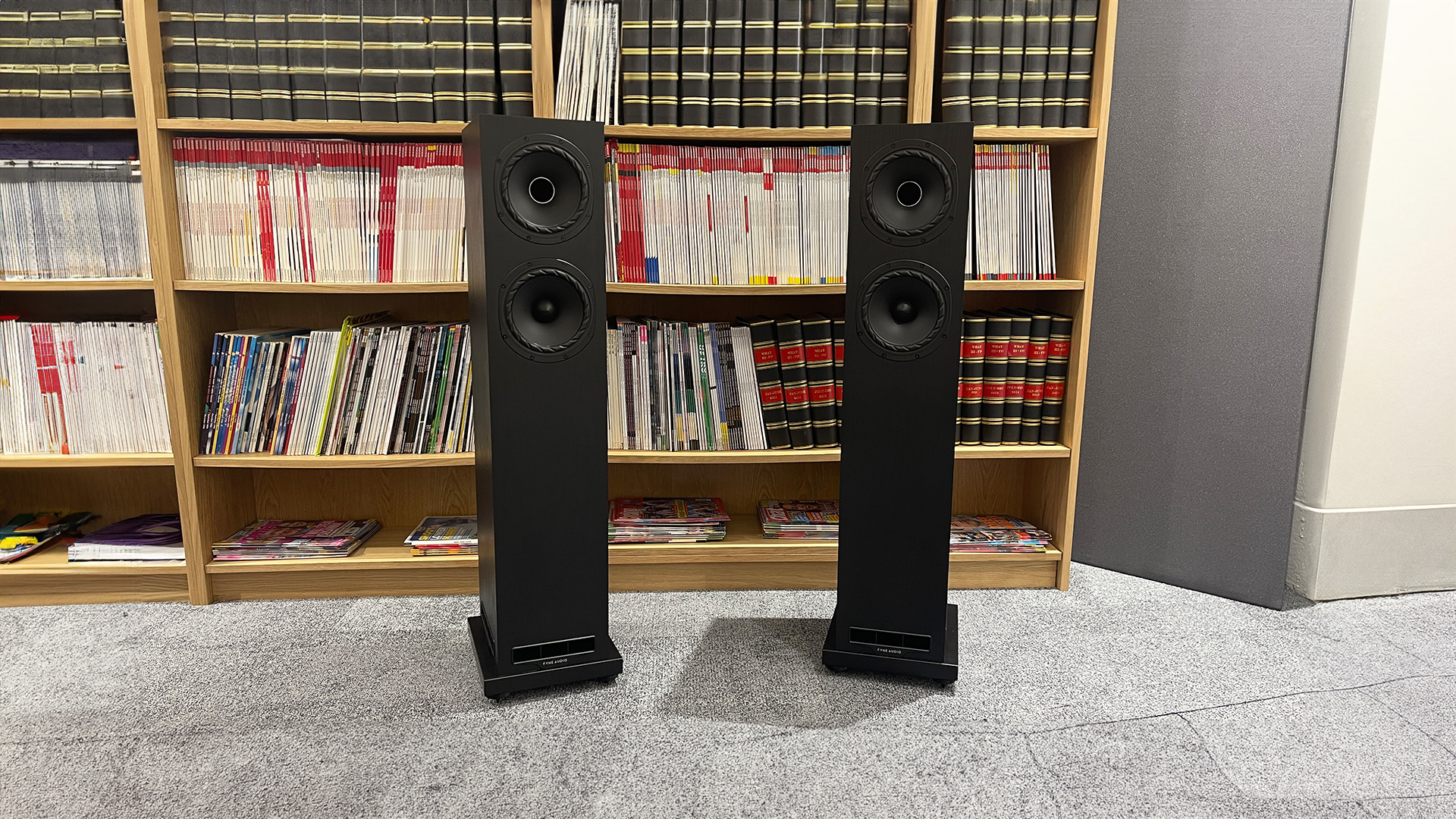


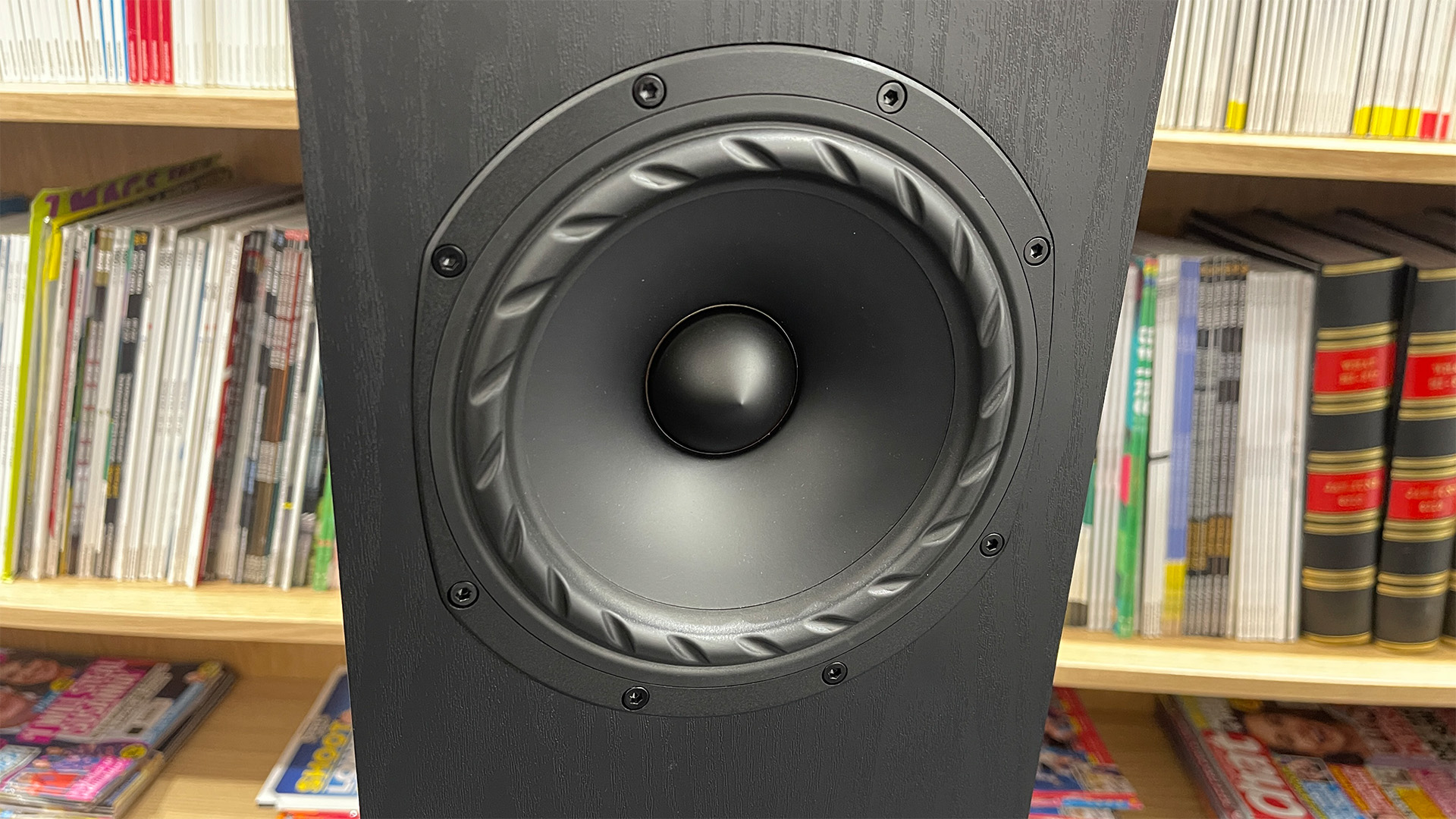



Specifications
Reasons to buy
Reasons to avoid
Fyne Audio's new entry-level floorstanders are aggressively priced. The 501E incorporate the brand's proprietary Isoflare driver technology that we've only seen in more premium models so far, and these floorstanders deliver a performance that outstrips their more established rivals at this midrange price.
To keep prices down, the brand has sacrificed visual cosmetics in exchange for ultimate performance, which means you can only get the 501E floorstanders in a single (and somewhat plain) black ash finish. The build quality is solid, though, and the speakers are peppered with clever technology to ensure they are relatively unfussy with placement and partnering. The Isoflare arrangement delivers an integrated sound with a very even and wide dispersion. The low frequencies are spread evenly thanks to a downward port design, vents and Basstrax technology, which disperses bass evenly across a 360-degree spread – allowing these towers to be less fussy about room placement.
The 501E are tremendously fun to listen to, with a fluid and expressive way with all music genres. Rhythm and dynamic shifts are handled with control and subtlety, with instruments and voices sounding natural. The overall sound is crisp and clear, with a nicely balanced tonality – the top end is refined and doesn't get harsh or bright with challenging material, while the bass remains taut and tuneful while packing ample punch. We said in our review that the F501 deliver a "forthright performance with vocals that captures nuances and subtle shifts in intensity superbly. The rival Q Acoustics 5050 sound a touch disinterested and mechanical in contrast."
These are wonderfully insightful and capable floorstanders, balancing sophistication with muscularity, being able to communicate intimate recordings as well as full-blown orchestral crescendos with conviction. For their asking price, we couldn't ask for better. We are entertained, and we think you will be too.
Read the full Fyne Audio F501E review
Also consider: The very musical PMC Prodigy 5 would be our choice for the next level up if you have more to spend, but they will set you back twice as much. For more options at this price level, the Award-winning Q Acoustics 5050 and 5040 offer an alternative sonic balance and more finish options.
How to choose the best speakers for your turntable
When it comes to choosing the right speakers for your turntable, you need to do your homework so you know what you are looking for. The vast majority of speakers will need to be partnered with a stereo amplifier that has a phono preamp (aka phono stage) built-in, so they'll work with your turntable. If your amplifier doesn't have a phono stage, you can always add an external one to your system.
Alternatively, your turntable might come with a phono stage built-in already, but you'll still need an amplifier in between the speakers and the deck.
You can also use powered or active speakers that have amplification built-in, but this still doesn't get around the need for a phono stage in the chain. If you're yet to buy your turntable, it's worth thinking about getting one with a phono stage built-in (although we still stand by our assessment that a purist turntable will always sound better). Also, make sure your active speakers have a volume control if you're going down this route.
If your deck has Bluetooth, though, you can wirelessly connect your record player to any Bluetooth speaker, be it a single unit or stereo pair. It's a convenient way to connect, for sure, but perhaps not the best in terms of pure sound quality. It's a trade-off of convenience versus sound quality – and only you can tell whether it's one you're happy to make.
Of course, it's always worth making sure you check your budget and ensure you're buying a speaker that matches the turntable at the right level. A cheap pair of speakers won't do justice to your turntable that's worth thousands, for instance, and it's always worth auditioning speakers, if you're able to, before making a final purchase.
How we test speakers for turntables
Here at What Hi-Fi? we review hundreds of products every year, including plenty of speakers of all shapes, sizes and types with a selection of our favourite turntables. So how do we come to our review verdicts? And why can you trust them?
The What Hi-Fi? team has more than 100 years experience of reviewing, testing and writing about consumer electronics. We have state-of-the-art testing facilities, where our team of expert reviewers do all our in-house testing. This gives us complete control over the testing process, ensuring consistency. We always ensure we spend plenty of time with the speakers and turntables, trying them with different electronics and with different music.
All products are tested in comparison with rival products in the same category, and all review verdicts are agreed upon by the team as a whole rather than a single reviewer, helping to ensure consistency and avoid individual subjectivity.
From all of our reviews, we choose the top products to feature in our Best Buys, such as this one. That's why if you take the plunge and buy one of the products recommended above, or on any of our other Best Buy pages, you can be confident you're getting a What Hi-Fi?-approved product.
You can read more about how we test and review products on What Hi-Fi? here.
Recent updates
- March 2025: Added the Fyne Audio F501E as the new best premium floorstanders option, with the Q Acoustics 5040 remaining an also consider. Updated relevant product suggestions for entries.
- January 2025: Checked all information and products are correct.
- October 2024: Added 'also consider' alternatives for each product for even greater variety of options at each price/combination, and What Hi-Fi? 2024 Award winners have been labelled.
MORE:
See the best speakers to suit all budgets
Cut your spending with the best budget hi-fi speakers
Or cut the cables with the best wireless speakers
Get the What Hi-Fi? Newsletter
The latest hi-fi, home cinema and tech news, reviews, buying advice and deals, direct to your inbox.

Kashfia is the Hi-Fi and Audio Editor of What Hi-Fi? and first joined the brand 13 years ago. During her time in the consumer tech industry, she has reviewed hundreds of products (including speakers, amplifiers, turntables and headphones), been to countless trade shows across the world and fallen in love with hi-fi kit much bigger than her. In her spare time, Kash can be found tending to an ever-growing houseplant collection and shooing her cat Jolene away from spinning records.

